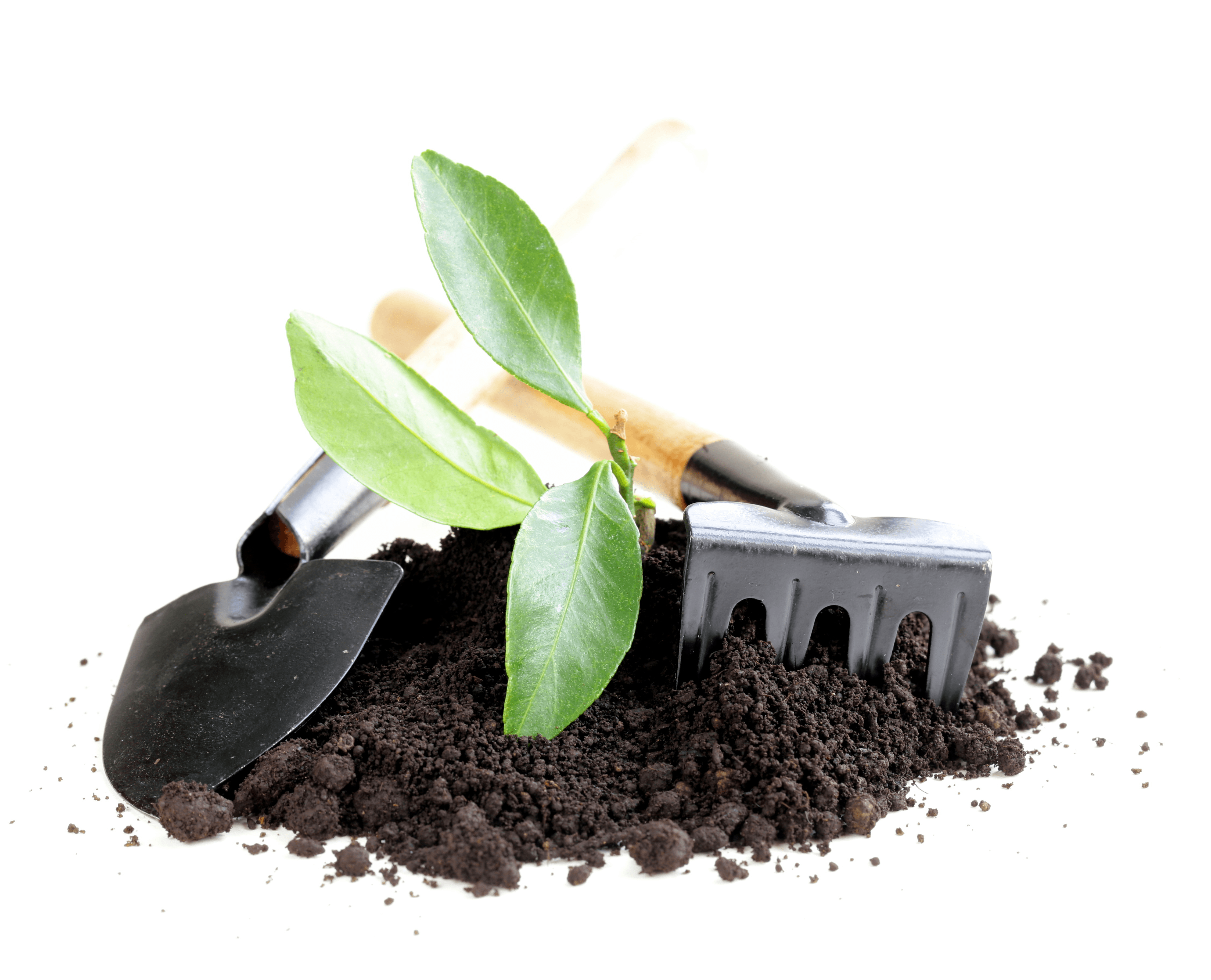How Do You Propagate Mammillaria?
These cacti are easy to multiply via two propagation methods: seed or offsets (pups) from the mother plant.
The pincushion cactus spring up in clusters around the base of the parent plant. To propagate them, remove them carefully using a very sharp, sterile blade or simply pull them away.
Lay the offsets on a clean paper towel in a sheltered, airy setting for a few days. This will allow a callus to form over the cut or area where the pup was separated from the parent plant.
When a callus has formed, you can put the pup into its own pot. Keep it in a warm, sheltered place with bright, indirect sunlight until it takes root.
This may take a few days or a few weeks. Once the plant has established roots, you can treat it just like the mature parent plant.
Уход за кактусом маммиллярия
Рассмотрим, как правильно ухаживать за кактусом маммиллярия.
Свет
Растение очень светолюбиво. Но почти все виды не терпят попадания прямых лучей солнца. В особенно хорошем освещении нуждаются опушенные экземпляры.
Температурный режим
Маммиллярия, уход за которой заключается и в поддержании температурного режима, любит умеренные показатели. В период зимы наступает период покоя. Показатели в это время должны быть от 7 до 10 градусов в условиях сухого содержания. Пушистые виды требуют температуру около 15 градусов. Летом растению необходим свежий воздух. Поэтому лучше всего в это время располагать цветок в саду или на балконе.
Полив маммиллярии
Если зимует растение в холодном режиме, то полив осуществляют не чаще раза в месяц. Обильность регулируется намоканием верхнего земляного слоя. Некоторые виды в холодное время года вообще не поливают. С наступлением весны поить растение нужно чаще. Воды требуется чуть больше, чем для намокания только поверхностной части грунта
Важно не допускать его высыхания. Цветок маммиллярия в жару требует увеличения объема и обильности полива. С осени режим снова делают более редким, подготавливая растение к зиме
С осени режим снова делают более редким, подготавливая растение к зиме.
Влажность воздуха
Летом на пользу пойдет орошение из очень мелкого опрыскивателя. Выполнять это надо до или после активного солнца. Но считается, что данный кактус не боится сухого воздуха.
Грунт
Субстрат можно создать самостоятельно. Для этого потребуется смешать по одной доле торфяной, листовой, дерновой земли и песка. Для зрелых экземпляров дерновой грунт нужно добавлять в объеме двух частей.
Маммиллярия в домашних условиях требует широкие и неглубокие горшки формы. Нужна ежегодная пересадка кактуса маммиллярия. Дальше уже ее можно выполнять каждые два года.
Размножение маммиллярии
Большинство разновидностей кактуса с легкостью образует на себе много черенков-деток. Со временем это может привести к вырождению цветка. Стебли вытягиваются и становятся маленькими, колючки и бутоны цветов тоже меняют свой вид.
Поэтому лучше иногда возобновлять его из семян. Температура почвы для их прорастания должна находиться в диапазоне 20-25 градусов. Такие меры помогут получить красивое и сильное растение.
Вредители
Маммиллярию, особенно разновидности с опушением, часто атакует красный клещ. Поэтому полезно будет проводить профилактику. Цветок протирают спиртом с помощью кисточки. Если вредители уже появились, то можно использовать 0,15% раствор актеллика.
Пересадка
Посадка Маммиллярии проводится в небольшие емкости с хорошим дренажем и обязательным отверстием внизу горшка. Для посадки лучше брать небольшие и неглубокие емкости. Для эффектности можно организовывать кактусовые садики. То есть посадку нескольких разных экземпляров в плоские, широкие плошки.
Грунт должен быть рыхлый. Можно использовать готовые специализированные грунты для Кактусов. Не стоит сажать Маммиллярии в чистый песок. Данный вид Кактуса не относится к Пустынным видам.
Что касается пересадки, то здесь надо ориентироваться на само растение. Увеличивать горшок надо постепенно — на 2-3 см в диаметре. Пересадку проводить только в состоянии активной вегетации растения (весна или лето). После пересадки растение помещают на 2-3 дня под рассеянный свет, без доступа обжигающих солнечных лучей.
Уход за комнатным растением Маммиллярией включает и подкормки. Удобрения вносят в жидком виде в период вегетации. Удобрение лучше брать специальные для кактусов. Так как в них подобран оптимальный баланс всех необходимых питательных веществ и микроэлементов. В период покоя удобрять кактусы нельзя!
What Are Some Common Pests & Problems Affecting Mammillaria?
Most problems with cactus grown as houseplants involve bacterial or fungal diseases that are caused by excessive watering.
This is why it is very important to establish a sparing watering schedule and observe your plants carefully for any signs of rot.
These include black spots around the base of the plant and mushy flesh.
In addition to problems caused by overwatering, common houseplant pests are sometimes problematic. Among these are:
- Root Mealy Bugs
- Fungus Gnats (small black flies)
- Spider Mites
- Mealy Bugs
- Scale Insects
It can be very hard to get these pests under control once they are established because they are very small and hide quite effectively.
Some of these pests have protective coatings that make it difficult to reach the actual insect with a pesticide or natural treatment.
To make matters worse, many common plant pests have developed resistance to commercial pesticides.
That’s why it is smart to maintain an Integrated Pest Management (IPM) strategy when dealing with any and all garden and houseplant pests.
What Are Cactus Mammillaria Related To?
The pincushion cactus is often confused with several other types of small cacti (e.g., Neolloydia, Epithelantha, and Coryphantha). This confusion has led to as many as 400 different species being mistakenly identified in the past.
A great deal of meticulous research in the field, along with genetic analysis has gone into sorting out this jumble.
Now botanists are confident that the genus contains around 300 species.
You won’t find most of the many species offered in nurseries, garden centers, and shops.
The varieties for sale as houseplants are typically small and grow close to the ground in the wild.
To recognize a true Mammillaria cactus, look for its spirally arranged, succulent nipple-shaped tubercles.
Interestingly, the spines of true cactus Mammillaria are arranged according to the Fibonacci sequence.
This means that each row of tubercles is equal in number to the sum of the two rows immediately above it.
When you view the pincushion cacti from above, you should notice that it has a very organized and orderly appearance.
Table Of Contents
When Should Mammillaria Cactus Be Repotted?
You should not need to repot your cactus more than once every couple of years. They do well with crowded root systems but will need repotting if the cactus becomes top-heavy or the pot becomes overcrowded with offsets.
Naturally, you should replace the potting soil every couple of years because it will become depleted, and salts may build up from water over time.
It is best to repot at the start of the growing season, but it may be done almost any time of the year.
Don’t water before repotting the cactus, as it is easier to knock away dry soil from the roots, and potting in dry soil helps prevent the risk of root rot.
Examine the roots carefully and cut away any portions that appear to be dead or rotten. Treat the areas you cut with a spritz of hydrogen peroxide or a fungicide. Learn more about using Hydrogen Peroxide for plants.
Put the plant into its new pot with drainage holes and surround it with your prepared cactus mix. Spread the roots out to give them room to grow.
Don’t water right away. Wait about a week, and then give the plant a light watering. Doing this helps prevent root rot.
Other Mammillaria Cactus Varieties to Grow:
- Mammillaria Cristata (Brain Cactus)
- Mammillaria gracilis (Thimble Cactus)
How Do You Tell If You’re Overwatering Mammillaria Cactus?
Remember, these cactus plants don’t just tolerate drought, and they need it. Their roots are very susceptible to rot, and it’s easy to kill them with too much water.
It may not seem that way at first, though. When a cactus first receives too much water, it may become very plump and begin putting out new growth.
Even when this is happening above ground, the roots are sure to be suffering under the soil.
When cactus roots become waterlogged, they start dying and rotting. Gradually, the rotten roots cause the seemingly healthy plant to start deteriorating.
The flesh becomes discolored and begins to soften. When this starts to happen, it may be too late to save the plant.
That’s why it is so important to monitor your cactus carefully and look for soft, discolored spots around the base of the plant.
How Do You Save An Overwatered Mammillaria Cactus?
If your cactus is showing signs of rot around the roots, you must remove it from its pot and use a sharp, sterilized blade to cut away the rotten parts.
Work from the bottom up, removing thin slices until you reach fresh, unaffected flesh.
Seal off the open cut with cornstarch, and allow the cutting to dry on a paper towel for a period of several weeks.
If your cutting is going to survive, it will produce a few roots during this time.
When this happens, carefully brush away the cornstarch and provide the cutting with its own new pot and fresh cactus mix.
Follow These 9 Smart IPM Tips!
#1 – Keep your plants healthy by providing the right environment and the correct care. Healthy plants are better able to resist disease and pests.
#2 – Always quarantine new plants for at least three weeks to avoid bringing in illness or hitchhikers. If you discover problems with a new plant, keep it separate and treat it or toss it.
#3 – Use natural treatments first. Spider mites and mealybugs can often just be washed off with a strong spray of water. Remember to cover the soil with plastic to prevent overwatering your cactus in the process.
#4 – Examine and clean the roots of cactus when repotting or transplanting. Root mealybugs can be washed off the roots with a strong spray of water. Blot excess water from the roots and allow them to air dry for a few hours before continuing with repotting or transplanting.
#5 – Examine your cacti often for signs of scale and mealybugs. If you see just a few, you may be able to remove them easily with a cotton swab dipped in rubbing alcohol.
#6 – You can spray your cacti occasionally with a diluted rubbing alcohol solution. Mix up one part alcohol with three parts water for a spray that will help deflect these pests. Be sure to test spray a small spot on the plant before spraying the entire plant. Some cacti are sensitive to rubbing alcohol.
#7 – Trap fungus gnats with yellow sticky traps or set up small jars of apple cider vinegar (ACV) to trap them. To do this, you’ll need a small jar with a lid. Punch small holes in the lid (or use an old spice bottle that already has a lid with holes).
Pour about half an inch of ACV into the jar and screw on the lid. Place the jar among your plants. Gnats will fly in to get the ACV and won’t be able to get out, so they’ll drown in the ACV.
#8 – Make milder insecticides your first choice, applied sparingly and only when necessary. Neem oil and pyrethrins are good choices.
#9 – If you have a problem with pests that are hard to reach with sprays, use systemic insecticides such as acephate and imidacloprid. Follow the packaging instructions carefully.
Приметы и суеверия
Народные поверья приписывают кактусам самые разные свойства, но сходятся в одном: если за растением тщательно ухаживать, оно обязательно принесет удачу.
Цветущий кактус предсказывает хозяйке перемены в личной жизни к лучшему: одинокая девушка встретит счастье, а замужняя может ожидать прибавления в семье. Если кактус зацвел, можно ждать и финансового прибавления или повышения по службе, особенно если цветет кактус на работе. Засыхание кактуса предвещает проблемы в семье, отсутствие любви и понимания. Осыпавшиеся иголки говорят, что кто-то желает вам зла, а сгнивший кактус показывает, что о вас плохо говорят.
Mammillaria Cactus Quick Care Tips
- Botanical Name: Mammillaria crinita
- Common Name(s): Pincushion Mammillaria Cactus
- Synonyms: Mammillaria crinita subsp. crinita
- Family & Origin: Cactaceae family, native to Mexico
- Growability: Easy to grow
- Grow Zone: USDA zones 9-11
- Size: Grows up to 6 inches tall and 6 inches wide
- Flowering: Produces pink or white flowers in the spring
- Light: Needs bright, direct sunlight
- Humidity: Prefers low humidity
- Temperature: Thrives in warm temperatures between 60-80°F
- Soil: Well-draining soil mix
- Water: Water sparingly, allowing soil to dry out between waterings
- Fertilizer: Fertilize once a month during the growing season with a cactus fertilizer
- Pests & Diseases: Susceptible to mealybugs, spider mites, and root rot
- Propagation: Propagate through offsets or seeds
- Plant Uses: Makes a great addition to a cactus or succulent garden, can also be grown indoors as a houseplant.
14 Most Popular Mammillaria Varieties
Mammillaria lower classifications.
#1 – Mammillaria tetrancistra (common Fishhook cactus) is found in the Sonoran and Mojave deserts in the northern part of Mexico and in the southwestern US. It grows happily in a wide variety of desert settings. This plant has soft, white spines with a central, curved spine. Flowers are showy and pink.
#2 – Mammillaria backebergiana (Pincushion Cactus, known in Ukraine as Bakerberg Mammillaria) is a columnar cactus. Its sharp spines are yellow or yellowish/brown. The cactus produces large, purple flowers.
#3 – Mammillaria plumosa (feather cactus) is a low-growing, clumping plant. It forms dense mounds that can cover quite a bit of ground with close-set, white, feathery spines. The flowers are off-white/yellow and sweetly fragrant.
#4 – Mammillaria spinosissima (Red-Headed Irishman) is very common the world over. It is easy to find this cactus offered in nurseries and other purveyors of plants. The plant has reddish, rusty-colored spines.
#5 – Mammillaria baumii (Golden Pincushion Cactus)is a low-growing, clumping species with dense central spines that obscure the stems. The funnel-shaped flowers are golden yellow and very fragrant.
#6 – Mammillaria elongata (Gold Lace Cactus, Ladyfinger Cactus) is available in a variety of shapes and colors. One version has copper-colored spines, another has regular white/tan spines, still others are oddly shaped (crested and brain-shaped). Flowers may be either pink or yellow.
#7 – Mammillaria zeilmanniana (Rose Pincushion Cactus)grows in clusters covered with dense, white “hair.” The flowers are deep red/violet.
#8 – Mammillaria bocasana (Snowball or Powder-puff pincushion) is extremely hardy. This cactus grows in clumps and is covered with dense, soft-looking white “hair.” Be careful, though. Sharp fish-hook spines are hidden beneath the hair. The flowers of this species are quite small and may be white, yellow, or pink.
#9 – Mammillaria candida (Snowball Pincushion) is a clumping ball-shaped plant covered with pink-tipped, white spines. Cream-colored flowers emerge early in spring and transition to pink as the season progresses.
#10 – Mammillaria elegans (Pincushion Cactus)is a globular cactus hailing from Mexico. The cactus has white spines, soft wool, and deep magenta flowers that last for an extended period of time.
#11 – Mammillaria hahniana (Old Lady Cactus or Superba) grows as a solitary specimen. This cactus is spherical in shape and produces dense, short white hairs. The flowers are reddish/purple. These very attractive cacti are hardy, carefree, and easy to grow.
PinA Mammillaria hahniana (Old Lady Cactus or Superba) growing in gravel as a solitary specimen in Scotland greenhouse.
#12 – Mammillaria matudae (Crawling Log or Giant Snake) has a mounding growth habit that manifests as long, snaking stems. https://hgic.clemson.edu/factsheet/indoor-cacti/
#13 – Mammillaria longimamma (Nipple Cactus, Finger Mound, Peyotillo)is unusual looking and quite popular with its “long nipples” (longimamma). The spines of this cactus are thin and sparse. Its flowers are a lovely, bright yellow.
#14 – Mammillaria rhodantha (Rainbow Pincushion)is a very popular, easy-to-find, easy-to-grow cactus. It has a solitary growth habit and may have either red or golden spines. Its flowers are pink.
Best Uses For Mammillaria Cactus Indoors or Outdoors
There are so many different types of Mammillaria cactus that, no matter what your setting or purpose, you can surely find a variety to suit your needs.
Some species are quite delicate and suited to a sheltered indoor setting. Some are rugged, low growing, and fast-spreading and make marvelous additions to rock gardens and other challenging settings.
Still, others grow quite tall and exhibit isolated growth patterns, making them ideal as specimen plants in a cactus garden or centrally located planter.
A mini cactus garden is a good way to display several different varieties of Mammillaria indoors!
This video shows many of the more rugged varieties of the genus Mammillaria in their natural habitat, where the cactus grows, and could inspire some great ideas for using Mammillaria in your own desert landscape.
Уход за кактусом в домашних условиях
Уход за кактусом заключается в соблюдении ряда правил.
Оптимальные условия для растения обеспечивают:
- Освещенность – зеленые колючие кактусы не любят ярких солнечных лучей, а опушенные отлично чувствуют себя на солнечной стороне;
- Полив – лишняя влага губительна для маммиллярии, поливать растение нужно не часто, а количество воды должно быть минимальным, чтобы только слегка увлажнить грунт;
- Температура – летом кактус способен перенести любую жару без ущерба для роста и цветения, а в зимнее время лучше всего держать растение в прохладном месте, где температура воздуха не бывает выше +15 градусов;
- Влажность – это условие не принципиально для маммиллярии, но если изредка опрыскивать его ствол, то кактус будет выглядеть более ухоженным и здоровым;
- Подкормка – удобрять растение нужно только в момент цветения, для этого используются специальные составы для кактусовых, которые продают в магазинах;
- Пересадка – взрослые растения нуждаются в пересадке не чаще 1 раза в 3 года, а молодые пересаживают каждый весенний сезон.
Чтобы кактус маммиллярия чувствовал себя комфортно, для него нужно выбирать неглубокий, но достаточно широкий горшок. При пересадке растения обязательно укладывается на дно слой дренажа, а грунт лучше всего использовать из смеси песка, дерновой и листовой земли. Подойдет и специальный субстрат для кактусов.
Mammillaria Cactus Care
Care instructions for this genus of cacti vary greatly depending on the species you select and how you choose to use this succulent plant.
Rugged outdoor plants require very little care. Keeping a cactus Indoors is another matter entirely.
When you keep indoor cactus, be sure to set up a sunny location in a room with a south-facing window during the wintertime.
This setting provides the most sunlight. A window location is typically a bit cooler than the rest of the room, and this cool temperature during the winter months is necessary to spur Mammillaria to bloom during the growing season.
In the spring and the summertime, vary the location to provide your Mammillaria cacti with the most light and heat.
Giving your plant an outdoor vacation in direct sunlight is a good idea.
How Often Should Indoor Mammillaria Cactus Be Watered?
During the growing season, let the top couple of inches of soil dry out before watering these succulent plants. Water the plant thoroughly, allowing excess water to run off.
If your plant has a drip tray, be sure to empty it. These plants should never stand in water.
How Long Can You Go Without Watering A Mammillaria Cactus?
In wintertime, cut back on watering. You should only water about once a month and then quite sparingly. Just give the plant enough water to prevent it from shriveling up.
Be sure to keep your plant at about 50° degrees Fahrenheit during the winter and provide plenty of indirect light.
How Much Fertilizer Does A Mammillaria Need?
You can fertilize your Mammillaria with a specially formulated cactus fertilizer or a very weak solution of houseplant fertilizer that is low in nitrogen and high in potassium and phosphorus.
Don’t overfeed your cactus, as this will encourage green growth and discourage blooming.
Schultz Cactus Plus 2-7-7 liquid Plant Food, 4-Ounce
Pin
Buy Now
If you click this link and make a purchase, we earn a commission at no additional cost to you.
What Type Of Potting Soil Is Best For Mammillaria Cactus?
When you repot your pincushion cactus, you can use a prepared cactus/succulent potting soil or make up your own cactus mix to get the soil texture you want using a combination of one part potting mix, one part coarse builder’s sand, and one part loam. Adding pumice will also help improve drainage.
Moreover, ensure the soil mix has good drainage and aeration.
Виды маммиллярий
Маммиллярия удлиненная (Mammillaria elongata) — с тонким удлиненным стеблем, сосочки не высокие, колючки золотистого цвета собраны в аккуратную розетку. Цветет мелкими белыми цветками, но только в благоприятных условиях, хотя, в общем, хорошо растет в комнатной культуре. Ягоды образуются после переопыления.
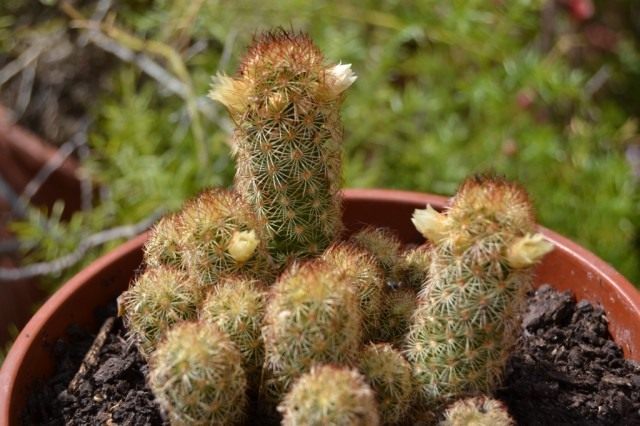 Маммиллярия удлиненная (Mammillaria elongata). Ryan Somma
Маммиллярия удлиненная (Mammillaria elongata). Ryan Somma
Маммиллярия колючейшая (Mammillaria spinosissima) — с шаровидным стеблем и тонкими, острыми колючками белого и коричневого цвета. Между сосочками опушение, как будто белые ватные шарики. Цветет ярко-розовыми цветками.
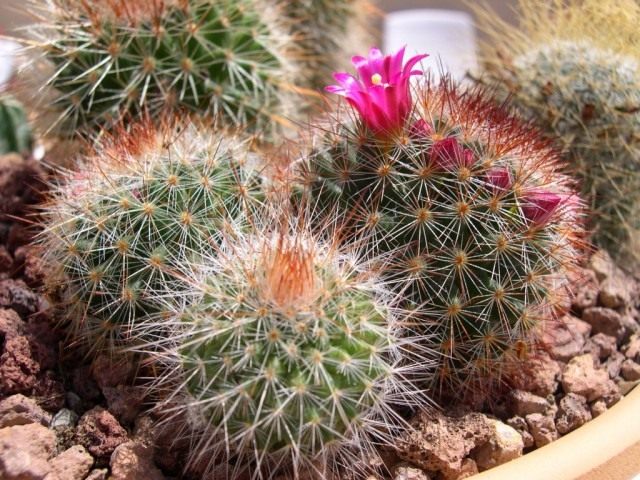 Маммиллярия колючейшая (Mammillaria spinosissima). Jose Luis
Маммиллярия колючейшая (Mammillaria spinosissima). Jose Luis
Маммиллярия Вильда (Mammillaria wildii) — с удлиненным толстым стеблем, до 5 см в диаметре. Сосочки тонкие, удлиненные с золотистыми колючками, центральная колючка загнута крючком. Легко образует детки, которые сами не отпадают, а продолжают расти, в результате кактус сильно ветвится. Цветет легко белыми не большими цветками. Ягоды образуются после переопыления.
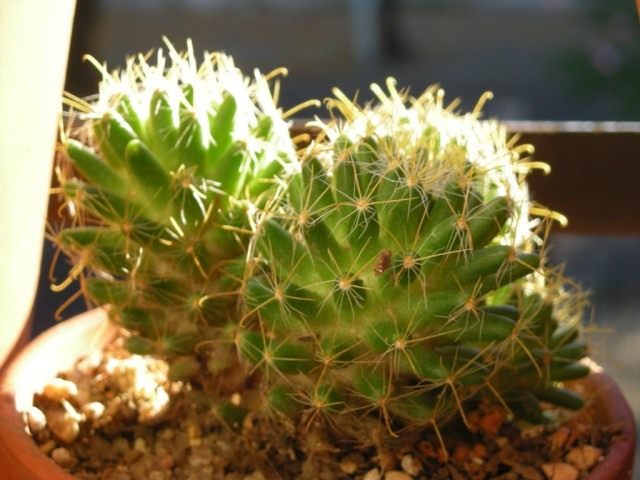 Маммиллярия Вильда (Mammillaria wildii). Maxy_Mercado
Маммиллярия Вильда (Mammillaria wildii). Maxy_Mercado
Маммиллярия Зейльмана (Mammillaria zeilmanniana) — с коротким цилиндрическим стеблем и густыми загнутыми колючками. Цветки ярко-розовые, иногда белые весной.
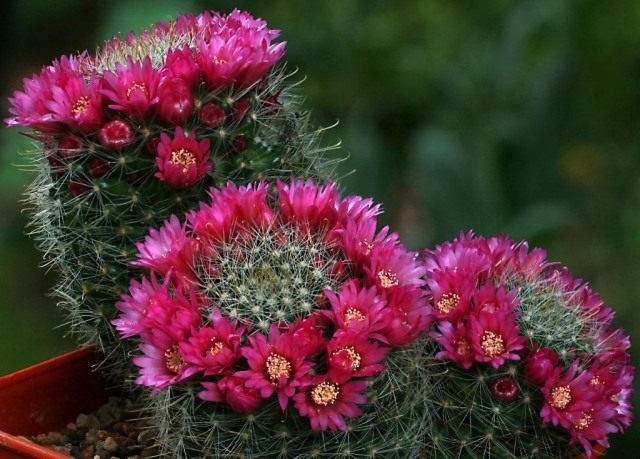 Маммиллярия Зейльмана (Mammillaria zeilmanniana). David Traish
Маммиллярия Зейльмана (Mammillaria zeilmanniana). David Traish
Маммиллярия превосходная (Mammillaria perbella) — с шаровидным стеблем, до 6-7 см в диаметре с небольшими белыми колючками. Легко образует много деток. Цветет розовыми или красными цветками.
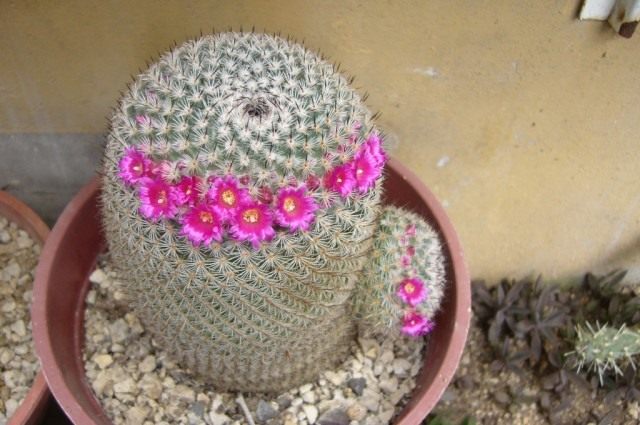 Маммиллярия превосходная (Mammillaria perbella). Jaime Campos Palacios
Маммиллярия превосходная (Mammillaria perbella). Jaime Campos Palacios
Маммиллярия Гана (Mammillaria hahniana) — с шаровидным или цилиндрическим стеблем (до 10 см в диаметре) и длинными белыми волосками, эта пушистая маммиллярия цветет розовыми цветками. Легко образует много деток.
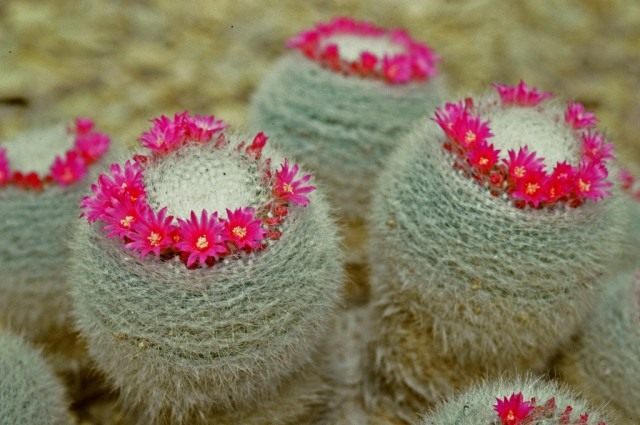 Маммиллярия Гана (Mammillaria hahniana). Lotus-Salvinia
Маммиллярия Гана (Mammillaria hahniana). Lotus-Salvinia
Маммиллярия бокасанская (Mammillaria bocasana) — с удлиненным толстым стеблем (4-5 см в диаметре), с тонкими длинными сосочками, образует много деток. Особенность в колючках — центральная коричневая колючка длинная и загибается крючком, несколько колючек тонкие игловидные, а также более длинные белые, волосовидные колючки. Эта маммиллярия также легко растет и цветет в комнатных условиях небольшими белыми цветками. Которые, когда их много, очень украшают растение. Ягоды образуются после переопыления.
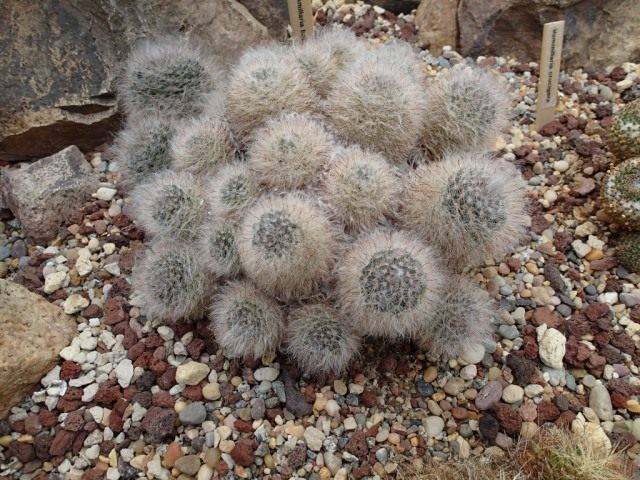 Маммиллярия бокасанская (Mammillaria bocasana). Jeff Wright
Маммиллярия бокасанская (Mammillaria bocasana). Jeff Wright
Маммиллярия побегоносная (Mammillaria prolifera) с невысоким тонким стеблем, легко образующим много деток. Колючки волосовидные и игольчатые, крайние белые, в центре золотистые, они плотно покрывают стебель так, что иногда его даже не видно. Легко зацветает белыми не большими цветками. Ягоды образуются без переопыления.
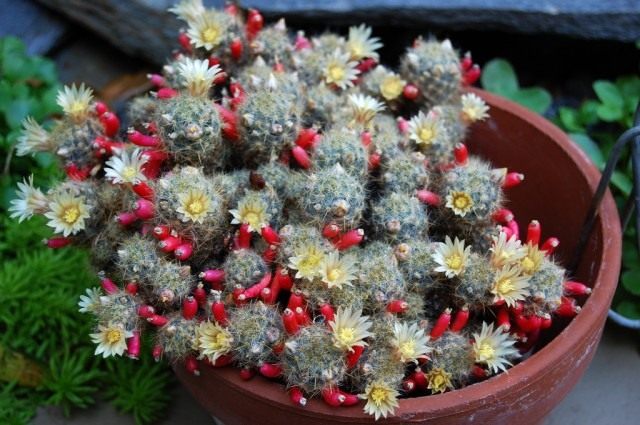 Маммиллярия побегоносная (Mammillaria prolifera). J R Linec
Маммиллярия побегоносная (Mammillaria prolifera). J R Linec
Growing Mammillaria Cactus Facts
Size & Growth vary greatly depending on the species. Some Mammillaria top out at an inch high, others at a foot high.
Flowering & Fragrance vary greatly from one pincushion cactus to another. All grow in a crown-like formation surrounding the top of the plant. Moreover, it has central spines or cushion-like areoles of blooms and has about 0.4 to 8″ inches in diameter stems.
Light & Temperature: Generally speaking, Mammillarias like warm temperatures (50° to 85° degrees Fahrenheit) and bright light. It thrives in full sun or partial shade exposure. It needs at least 2 to 6 hours of direct sunlight daily.
Watering & Feeding should be sparse year-round. During the spring, summer, and early fall, water thoroughly when the soil is almost dry.
During the winter, reduce watering by half. Provide a half-strength feeding of a balanced cactus fertilizer at the beginning of spring and toward mid-summer.
Potting Soil & Transplanting: The pincushion cactus prefers a fairly rich, well-draining cactus mix. Repot or transplant infrequently, as these plants do well when slightly root bound.
Grooming is Simple: Keep an eagle eye out for any signs of rot, and cut it away immediately if you notice it. Otherwise, separate and repot pups when they become overcrowded.
USDA Hardiness Zone: Mammillaria is generally hardy in USDA zones 8 to 11; however, this may vary from species to species. Refer to the USDA Plant Profile Pages for more specific information.
The various pincushion cactus species are native to habitats ranging from low desert to both cold and tropical forest settings. Their natural range extends across the southwestern US and throughout Central America.
Mammillaria Buying Tips
When shopping for Mammillaria or any cactus, there are a few things you can do to be sure of making the best purchase.
Buy your Mammillaria from a reputable dealer. Don’t gather them in the wild or purchase them from someone who may have done so. Cactus poaching is often illegal and leads to species extinction, which is a big problem.
Be sure the soil is dry. Remember that an overwatered cactus may look good on the top (for now), but bad things are happening underground. Always use well-draining soil.
Be sure that cactus is standing up straight. Leaning can be a symptom of lack of light or of root rot.
Bring a box to carry your cactus home. A plastic tote or cardboard box will protect your cactus (and you) from damage on the trip home.
It will keep the plant upright and prevent spilling soil out in your vehicle.
If there happens to be a little snake hiding in the soil (as has happened to this writer) it won’t be able to slither under the seat of your car if you put your new cactus in a box or tote.
Размножение
Детками
Большинство видов маммиллярий образуют боковые побеги – детки, которые можно использовать для размножения. Миниатюрные отростки отделяют от материнского стебля острым ножом, подсушивают 3 – 5 дней. Затем слегка вдавливают во влажный песок для укоренения.
Семенами
Кактусы рода склонны к вырождению и со временем могут полностью утратить сортовые особенности. Раз в 3- 5 лет для размножения стоит использовать семенной метод размножения (подробнее ниже).
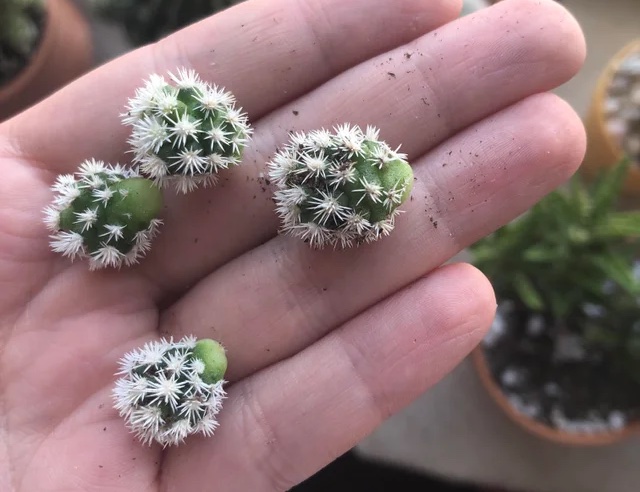 Черенки маммиллярии @ u/cfreesquared, Reddit
Черенки маммиллярии @ u/cfreesquared, Reddit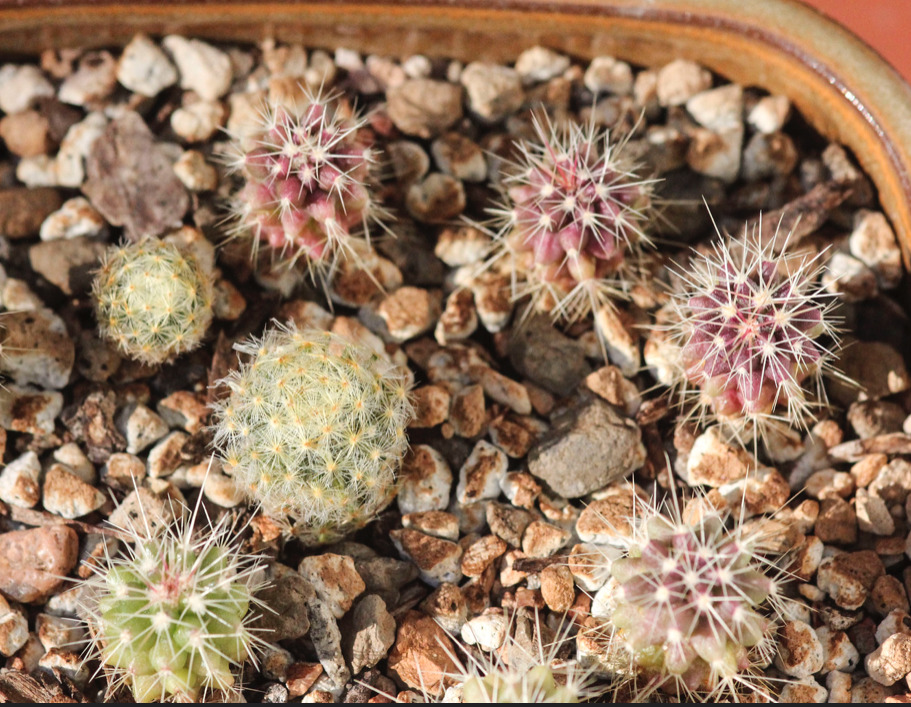 Сеянцы маммиллярии @Andrea Afra
Сеянцы маммиллярии @Andrea Afra
Правила посева:
- Оптимальная емкость: рассадная тепличка-контейнер с прозрачной крышкой. На дно контейнера укладывают дренаж, затем насыпают рыхлый субстрат, слегка его утрамбовывают и увлажняют из пульверизатора.
- Семена маммиллярии помещают на 30 минут в бледно-розовый раствор марганцовки температуры 40-45 градусов. Затем раскладывают пинцетом или зубочисткой на поверхности субстрата и присыпают крупным речным песком слоем в 2-3 см.
- Тепличку закрывают и помещают в светлое, теплое место. В процессе проращивания крышку ежедневно открывают на 10-15 минут для проветривания. Конденсат с крышки стирают салфеткой.
- Первые ростки кактуса появляются через 15-20 дней. Крышку с контейнера сразу снимают. К пересадке в отдельные горшочки диаметром 4-5 см молодые кактусы готовы через 7 – 10 месяцев.
